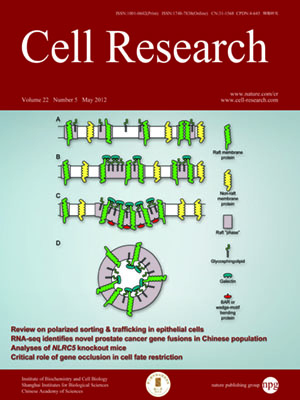Volume 22 Issue 5, May 2012: 822-835
ORIGINAL ARTICLES
Enhanced TLR-induced NF-κB signaling and type I interferon responses in NLRC5 deficient mice
Yanzheng Tong1,2,3,*, Jun Cui1,3,*, Qingtian Li1,3, Jia Zou1,3, Helen Y Wang1,3,4 and Rong-Fu Wang1,3,4
1The Center for Cell and Gene Therapy, Baylor College of Medicine, Houston, TX 77030, USA;
2Institute of Biosciences and Technology, Texas A&M University Health Science Center, Houston, TX 77030, USA;
3Center for Inflammation and Epigenetics, The Methodist Hospital Research Institute, Houston, TX 77030, USA;
4Department of Pathology and Immunology, Baylor College of Medicine, Houston, TX 77030, USA
Correspondence: Rong-Fu Wang,(rwang3@tmhs.org)
Nod-like receptors (NLRs) are intracellular sensors that respond to a variety of pathogen and intracellular danger signals to induce innate immune responses. NLRC5 has recently been identified to be an important regulator of NF-κB, type I interferon (IFN) and inflammasome signaling pathways, but the
in vivo function and mechanisms of NLRC5 remain to be defined. Here, we describe the generation and characterization of
NLRC5 knockout mice. We show that induction of
NLRC5 expression by Toll-like receptor (TLR) ligand or cytokine stimulation requires the signal transducers and activators of transcription (Stat)1-mediated signaling pathway.
NLRC5 ablation reduces MHC class I expression, and enhances IKK and IRF3 phosphorylation in response to TLR stimulation or viral infection. Consistent with these observations, we found that
NLRC5 deficiency enhanced IL-6 and IFN-β production in mouse embryonic fibroblasts (MEFs), peritoneal macrophages and bone marrow-derived macrophages (BMMs), but not bone marrow-derived dendritic cells (BMDCs) after LPS stimulation or vesicular stomatitis virus (VSV) infection. Furthermore, we found that
NLRC5-deficient mice produced higher amounts of IL-6 and IFN-β in the sera when they were challenged with LPS or infected with VSV. Taken together, these results provide
in vivo evidence that NLRC5 plays critical roles in MHC class I expression, innate immune signaling and antiviral innate immune responses, thus serving as an important target for modulating innate immune signaling and regulation.
Cell Research (2012) 22:822-835. doi:10.1038/cr.2012.53; published online 3 April 2012
FULL TEXT | PDF
Browse 2285


